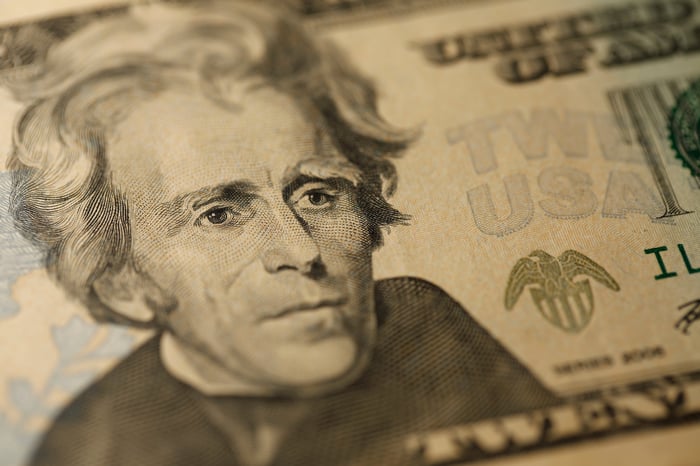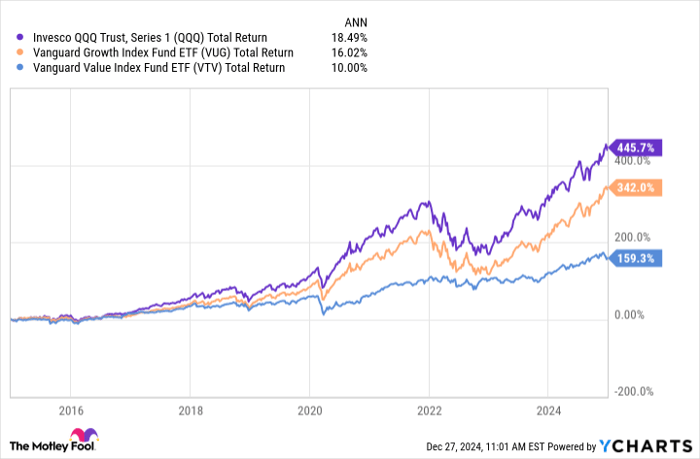Two hundred dollars isn't a life-changing amount of money. Nevertheless, if handled properly, it can still generate a nice return on your investment. With that in mind, let's examine one smart way to invest $200.
Image source: Getty Images.
Where to invest $1,000 right now? Our analyst team just revealed what they believe are the 10 best stocks to buy right now. See the 10 stocks »
Exchange-traded funds, the best way to start
Exchange-traded funds (ETFs) are one of the best ways to get started in the stock market. They are, in effect, a basket of stocks, grouped according to some characteristic.
For example, some ETFs focus on a particular sector, like financials or energy companies. Others choose stocks based on their size. Still others focus on country of origin, buying shares of stocks based in Japan, Germany, Brazil, etc.
Many different companies create and operate these ETFs, and the fees investors pay vary depending on the fund's strategy, its composition, and its costs. Let's examine a few different types of ETFs, and see which one stands out as the smartest choice right now.
Types of ETFs
There are thousands of ETFs, all created to serve a different purpose and audience. For example, the Vanguard Growth ETF (NYSEMKT: VUG) is an ETF loaded with growth stocks. Its top holdings include tech giants Apple, Microsoft, and Amazon.
Then there's the Vanguard Value ETF (NYSEMKT: VTV). This fund is focused on value stocks. Its top holdings include dividend-paying stocks ExxonMobil, Procter & Gamble, and Coca-Cola.
Finally, there's the iShares Top 20 U.S. Stocks ETF (NYSEMKT: TOPT). This fund narrows in on the 20 largest American stocks; its top holdings include Tesla, Apple, Microsoft, Nvidia, Alphabet, and Amazon.
Each of these funds caters to a different audience, but none of them are my top choice for an investor with $200 to put to work. Instead, I would focus on a different ETF: the Invesco QQQ Series I Trust (NASDAQ: QQQ). Here's why.
Why the Invesco QQQ Series I ETF is a smart choice for so many investors
This ETF is a smart choice for three reasons:
- It's designed to benefit from fast-growing tech companies.
- It boasts an excellent performance history.
- Its fees are low, making it a good fit for almost any portfolio.
Let's start with the fund's strategy. This fund is designed to track the Nasdaq-100 index, which includes the 100 largest non-financial companies on the Nasdaq exchange. As a result, the fund's top holdings are similar to, but slightly different from the Vanguard Growth ETF. For example, this fund still counts Apple, Microsoft, and Nvidia among its top holdings, but it excludes financial stocks like Visa and Mastercard.
Turning to performance, the Invesco fund has been one of the top-performing ETFs for a while. Over the last decade, for instance, the Invesco fund has generated a compound annual growth rate (CAGR) of 18.3%. That's far ahead of what the Vanguard Growth ETF (up 15.9%) produced, and it's almost double the return of the Vanguard Value ETF (up 10%).
QQQ Total Return Level data by YCharts
Finally, the fund offers a reasonable fee. Its expense ratio is only 0.2%. That means only $20 a year is paid in fees for an investment of $10,000. For a smaller amount, say $200, an investor will only surrender $0.40 in annual fees.
Given the combination of low fees, excellent performance, and solid strategy, the Invesco ETF is the perfect choice for an investor looking to put $200 to work right now.
Don’t miss this second chance at a potentially lucrative opportunity
Ever feel like you missed the boat in buying the most successful stocks? Then you’ll want to hear this.
On rare occasions, our expert team of analysts issues a “Double Down” stock recommendation for companies that they think are about to pop. If you’re worried you’ve already missed your chance to invest, now is the best time to buy before it’s too late. And the numbers speak for themselves:
- Nvidia: if you invested $1,000 when we doubled down in 2009, you’d have $355,269!*
- Apple: if you invested $1,000 when we doubled down in 2008, you’d have $48,404!*
- Netflix: if you invested $1,000 when we doubled down in 2004, you’d have $489,434!*
Right now, we’re issuing “Double Down” alerts for three incredible companies, and there may not be another chance like this anytime soon.
*Stock Advisor returns as of December 23, 2024
John Mackey, former CEO of Whole Foods Market, an Amazon subsidiary, is a member of The Motley Fool's board of directors. Suzanne Frey, an executive at Alphabet, is a member of The Motley Fool's board of directors. Jake Lerch has positions in Alphabet, Amazon, Coca-Cola, ExxonMobil, Invesco QQQ Trust, Nvidia, Procter & Gamble, Tesla, and Visa. The Motley Fool has positions in and recommends Alphabet, Amazon, Apple, Mastercard, Microsoft, Nvidia, Tesla, Vanguard Index Funds-Vanguard Growth ETF, Vanguard Index Funds-Vanguard Value ETF, and Visa. The Motley Fool recommends the following options: long January 2025 $370 calls on Mastercard, long January 2026 $395 calls on Microsoft, short January 2025 $380 calls on Mastercard, and short January 2026 $405 calls on Microsoft. The Motley Fool has a disclosure policy.
The views and opinions expressed herein are the views and opinions of the author and do not necessarily reflect those of Nasdaq, Inc.



